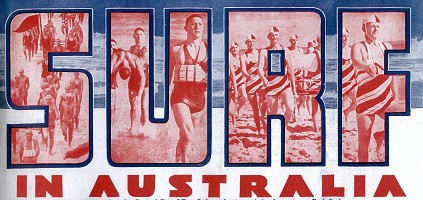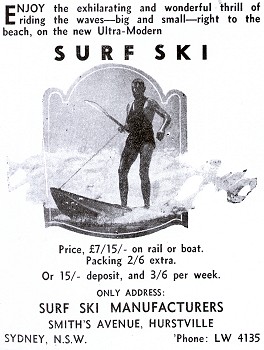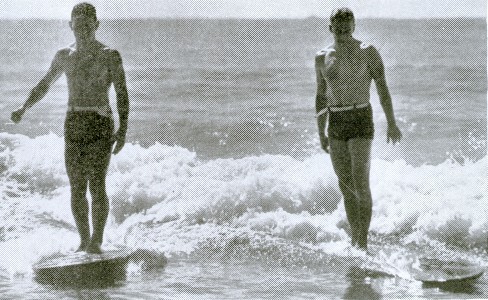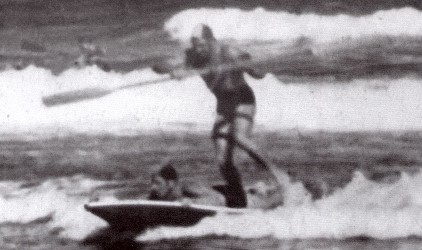 |
surfresearch.com.au
slsaa : surf in australia, 1937 |
| home | catalogue | history | references | appendix |
|

The ski or similar
craft has just been adopted by the Surf Association as a recognised item
of life-saving equipment.
It was not, however,
built for that purpose, being more essentially made for shooting or riding
the breakers.
It has several
advantages over both the surf board and the canoe.
Its superiority
over the surf board is that it can be driven by a paddle, it can be steered
by a paddle, it is more buoyant and less likely to injure the user.
The rider is
completely above the water and not so prone to attack.
For life-saving
it is more manageable with a patient.
Its improved
features over a canoe are that is is more easily managed, does not fill
with water or sink, and can be righted in the water much easier.
To place a patient
in a canoe is, of course, impossible.
As Honolulu gave
the surf board, Australia has given the ski, and it would not be surprising
to see in the near future surf skis for hire on the beaches.
Clubs are buying
them rapidly and the new craze is giving the surf board some very keen
opposition.
Jack Toyer, a
co-inventor, has been connected with the surf movement for some 15 years
and is Captain of the Cronulla Club boat crew.
Dr. J. S. Crackenthorpe
is an ex-Manly Club member.
The ski is the
result of patient experimenting over a period of about 12 months and was
patented in 1933.
Recently orders
for this craft have been received from Honolulu, New Zealand and South
Africa.
Australia has
been put on the map in so far as surf ski-ing is concerned by two of our
own members, another accomplishment in which we take pride.
 |
Surf Ski Manufacturers, Smith's Avenue Hurstville, NSW. Surf in Australia.
|

The team selected
from over 50 applicants is, however, a very strong one, and does not expect
defeat in New Zealand.
Twenty-five New
Zealand clubs are expected to attend the National Championship Carnival
on 13th February at Lyall Bay, Wellington.
The tour will
cost the New Zealand Association approximately £260, and the Australian
Association approximately £100.
Members of the
team will be insured against accident, sickness (including infantile paralysis),
and death.
Surfoplanes Ltd. are loaning a plane to each member and the Bondi Club are loaning a reel.
The financial support given by Clubs to the tour is disappointing to date, and every club is asked to send a guinea or two to assist defraying expenses.
North Narrabeen made a handsome donation of £25.
Blazers by David Jones, and Sweaters by "Speedo," should make the team look smart.
PROPOSED ITINERARY
There appeared
amongst these boys some that had been missing from the Baths for a few
Sundays, and they plainly stood out from the rest on account of the wonderful
colour of their bodies.
Inquiries were
soon made to know where they had been to become so brown.
Freshwater was
found to be the place - quite unknown to the writer then, but soon found.
Thus it was from
a visit to this beach and from later visits to Manly that the writer first
saw the art of shooting the breakers being practised.
This was done
by Freddie Williams, who, I am quite sure, was the father of the art as
regards our Sydney beaches.
We boys used to swim out into the green stuff and watch his actions, then having learnt a few of the essential things, we had a crack at it ourselves, until we got an idea of it, and developed it with varying successes, some of us to a high state of efficiency, others just mediocre.
Just imagine,
in those days there would not be more than fifteen or twenty people in
the water at Manly at anyone time on a Sunday morning between, say, 10
a.m. and 1 p.m.
The practice
then was to undress in a small elevated weatherboard shed at the far south
end of the beach, then to roll up the clothes, pack them on the long wooden
seat running along and below the promenade, and keep your eyes on them
until you had finished with the surf.
Talking about the number of surfers, can you realise that the writer can well remember being in the surf at Manly on a Boxing Day afternoon, and a perfectly good one at that, when the only other person with him was his companion, Charlie Duval, one of the well- known enthusiasts of that time. Now I wonder how many thousands would be in on a similar afternoon?
The habit of surfing
continued to grow, beaches became more and more popular, and sun hatching
became more difficult on account of regulations, etc.
We were forced
to make our way per horse tram to the northern end of Manly and then by
shanks' pony over the hill to Freshwater.
Here we became
again subject to regulations, policemen stalking us while we lay in the
sand dunes and baked, some with a liberal coating of cocoanut oil.
I shall always
remember how they smelled in those natural hot dug-outs, when the cocoanut
oil began to heat up, with the sun near the 100 degree mark in the shade.
It was always
necessary to keep a sharp lookout for police, but I have never been able
to ascertain the reason for their hunting us in such an out-of-the-way
place as Freshwater was in those days, with only about three or four houses
in the whole of the area, considering that our costumes were never rolled
down beyond the waistline.
However, such
was the case- I suppose it was the survival of the regulations that caused
the police to chase us from the water when we used to swim in the lagoon
formed by the reclamation work at the eastern side of Rushcutters' Bay,
because at that time no one was allowed to bathe between the hours of 6
a.m. and 6 p.m.
So back to Manly,
but this time Queenscliff.
Cutting out a
large circle in the tee-tree scrub on the cliff as our dressing place,
we started surfing at this end of Manly beach.
Strange to say,
we enjoyed more freedom there than we ever did at Freshwater, never being
disturbed by
the police.
Gradually, as
at all other places, this spot developed, until now it is an exceptionally
safe place for surfing with its efficient life-saving club.
We were told
by the wiseacres of the day that we were "mad wretches" to surf there and
ought to have our brains brushed.
Nothing, however,
happened, surfing continued on, and then the small hand surfboard was introduced.
I can well remember
one Christmas time I went to Thirroul with seven or eight fellows, several
of us taking our boards.
The first day
on the beach was delightful, with a perfect surf, and the sight of shooting
with boards must have been a new experience for the local boys, because
on the following day they appeared on the beach, apparently after an at-
...
Page 13
... tack on the
store of empty butter-boxes and fruit-cases, with boards of every shape
and size.
This first attempt
appears to have been fairly disastrous, as the following day no locals
were attempting the new art, but we could not help noticing a plentiful
supply of firewood strewn about the beach that represented the surfing
boards of the previous day.
Speaking of the
dangers of the surf, my mother, who is eighty-two years of age, told me
recently that sixty years ago, when she was a girl of twenty-two, she was
paddling on Manly beach with two young children when a Council Inspector
approached her and informed her that she must leave the water, as the beach
was considered to be very dangerous on account of treacherous currents
and undertows and people were not allowed to paddle.
What if that
Inspector could see the beach to-day!
Many have observed
the evolution in the art of surf shooting and reform in the mode of dress,
or undress, through the years.
Body shooting,
surf boards, surf boats, canoes, surfoplanes, surf skis are steps up the
ladder of progress.
Neck to Knee,
Two-piece Canadian, Costumes and Vees, the Skirted Costume and Trunks are
the milestones in wearing apparel.
There is little
left.
No longer hunted
from public gaze, the Australian youth, sun-tanned and healthy, disporting
to-day on the beaches in freedom, is the reply to those who have, and would,
endeavour to restrict our liberties by cumbersome and hypocritical regulations.
SURFOPLANES
AND SURF LIFE SAVING
By C. Smith (Bronte)
Inexperienced swimmers on surfoplanes have been the cause of several rescues during the past few seasons, but club members and others who are not enamoured of the rubber floats should take into account their advantages also.
Many bathers who have got into difficulties have been reached and supported, and even brought to the beach by club members on surfoplanes, and in the hands of an expert the floats are a distinct acquisition to the life saving gear of a club.
The Bronte club, through the generosity of Mr. D. Brown, Senior, has six floats for the use of members, and one or two are always to be found in the patrol areas, where they have come in very handy during rescue operations, particularly for bathers out of their depth fairly close to the shore, although club members have effected rescues well out, also with their help.
It is a remarkable
fact that every club member who has been prominent in inter-club surfoplane
events is also a first-class belt swimmer, showing that a strong stroke
is essential.
Jim Rigby, of
Bronte, who won the "Surfo" event at the championship gala, won four events
with one second out of the five times he competed during the 1936-37 season.
Over the past
three seasons Jim has been placed first, second and third in the Bronte
club belt championship.
R. Holcombe,
of Cronulla, has also been belt champion of his club, and George Canaway,
of Palm Beach, who is also prominent in these events, numbers the Australian
belt championship amongst his trophies.
Frank Adler,
present champion of the Bronte club, also won the Maroubra belt championship,
when a member of that club, and has won many surfoplane events and been
placed on innumerable occasions.
Colin Smith,
Bronte club champion of 1933-34, is another place-getter in these races.
| October 1, 1937,
page 4.
Skilled Surf Board
Riders
(Block by courtesy
of
|
 |
 |
Rose Surf Skis Sporting Boats & Caravans Pty. Ltd. Mentmore Avenue Rosebery, NSW. Surf in Australia.
|
|
Surf in Australia. Official Organ of the Surf Life Saving Association of Australia (Head Centre), 119 Phillip, Street Sydney. Published by Alexander Leo Finn, 149 Dover Road, Rose Bay. Printed by Lake and Ashes Pty Ltd., 389-391 Sussex Street Sydney. 1937. |
 |

| home | catalogue | history | references | appendix |